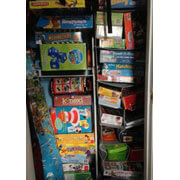 Now that the dust has settled after the holidays, like many families we’re left wondering: what are we going to do with all of these toys? Having been urban dwellers for so long with little to no storage space, organization has long been a trivial task for me. And just as soon as we’ve gotten the hang of suburbia again, we welcomed the baby and had to make room for a new wave of stuff. But it’s the toys that, quite possibly, perplex us the most. On my quest to streamline our organization overhaul of the kids’ playroom, I thought I’d share some helpful tips.
Now that the dust has settled after the holidays, like many families we’re left wondering: what are we going to do with all of these toys? Having been urban dwellers for so long with little to no storage space, organization has long been a trivial task for me. And just as soon as we’ve gotten the hang of suburbia again, we welcomed the baby and had to make room for a new wave of stuff. But it’s the toys that, quite possibly, perplex us the most. On my quest to streamline our organization overhaul of the kids’ playroom, I thought I’d share some helpful tips.
1. Purge before the next wave
Before major holidays and birthdays, purge old, broken, and neglected toys. In fact, if you tend to accumulate way too much stuff, make it a habit to regularly purge items. We use a bag system when we need to instill a little order in between major purges. Fill a bag of stuff with toys and objects that aren’t being played with or haven’t been used in at least a month. We then add that bag to our donation pile. It’s my older son’s responsibility to help keep things somewhat organized in the playroom. We determined that everything has a home in the playroom. After playtime, put stuff back where it belongs. If it doesn’t find its way back home, pieces get lost and clutter starts to take over. The bag system often comes in handy when things aren’t organized willfully.
2. Contain the chaos
Like many others, I’ve adopted the cubby organization style that works well in classrooms and daycares. Each cubby houses a specific sort of toy or game. Soon, we will be reshuffling so that the 5-year-old’s toys will take over the higher cubbies and the baby’s toys will be on the ground level. This reshuffle will (hopefully) aid in the separation of small objects and keep choke hazards out of reach for the baby. Safety tip: In addition to choking hazards, make sure heavy items are always out of reach and furniture is properly secured.
Another way to contain the excess of toys and entice a bit of novelty is to regularly rotate toys. All kids love new toys, and by storing a container full of toys to rotate every few weeks, new-old toys make for a fun way to reintroduce toys that the kids already own while helping to open up the valuable play space.
3. Behind closed doors
Because we opted to have our kids share a bedroom to keep the playroom, our play space has a closet. And in the closet, I like to make toys and games semi-accessible; I want the kids to be able to see it so they can play with it, yet need assistance to get access. The closet houses most of the puzzles and all of our board games. I keep the preschooler-type games at kid-level, while the more family-oriented games with the billion pieces up top. In addition to a basic closet organizer, we keep things intact with a canvas hanging shoe organizer.
4. Wide open
The main thing we’ve been struggling with lately is the lack of open play space. When big-ticket toys like kitchens, train tables, and forts take over valuable play space, it becomes less inviting to play in the playroom. One way to help with this is to make larger playthings serve double duty. Often times, train tables will have a drawer or trundle below, which doubles as storage. By incorporating ottomans that open up with storage, it makes room for seating beyond kid-sized chairs. As my 5-year-old learns to read, one of my focal points is making a reading nook, an area where he can unplug and dive into a book or three.
As I attempt to put order into our playroom once again, ultimately, any play area should have an open space for cars to race, dolls to dance, and imaginations to run wild.

